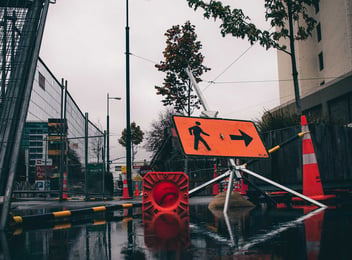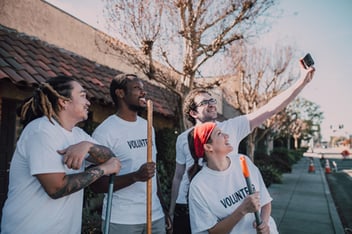Free Disaster Response Toolkit
Though disaster management is complex, its mission is clear: to mitigate the harmful effects of disaster. A key component of mitigating the harmful effects of any hazard is a scalable plan that optimizes the available workforce and can be implemented when disaster strikes. Volunteers, whether affiliated or unaffiliated/spontaneous, have various skills and resources they can offer during a disaster. When planned for, volunteers can make an invaluable impact by increasing response capacity through several different roles.
The Role of Disaster-Response Volunteers
Volunteers augment the community’s response capability by performing roles that require less technical training, allowing professionals to focus on the more highly specialized roles. This means volunteers may respond in multiple venues and hold varied roles throughout a single response.
Affiliated Volunteers
Highly Qualified Affiliated Volunteers (HQAVs) are volunteers who are attached to a recognized voluntary or non-profit organization. HQAVs are trained for specific disaster response activities and may fill many different roles. These roles can include search and rescue, damage assessment, medical services, emergency operations center (EOC) work, volunteer registration, and so much more. In fact, in communities across the country, local citizens are learning basic disaster-response skills and organizing into recognized voluntary organizations called Community Emergency Response Teams (CERTs) that can deploy to other areas when needed.
Spontaneous/Unaffiliated Volunteers
Working with Spontaneous Unaffiliated Volunteers (SUVs)—or volunteers who are not affiliated with a recognized disaster-response organization prior to a response—can be a challenge. However, if you plan to work with SUVs, it may be beneficial to pre-identify some roles they can fill during a disaster. When planned for, SUVs can provide many benefits. For example, they provide additional workforce, which can enable the HQAVs to fill more specialized roles. Following a hurricane or major flood event, for instance, SUVs can help with debris clean-up, mucking and gutting, mass feeding operations, and organizing, transporting, and delivering disaster-relief supplies. HQAVs, meanwhile, can focus on search and rescue missions, emergency operations center operations, or shelter management.
All-Hazards Planning and Managing a Disaster
Having an emergency-response plan enables organizations to effectively manage a disaster by providing clear guidance to those involved in the response, including volunteers and disaster-relief organizations. A jurisdiction’s Emergency Operations Plan (EOP) provides guidance on the roles and associated responsibilities of community organizations, while an all-hazards plan enables the team to recognize needs outside their community organizations’ response capacity.
Volunteers are a key resource for increasing the community’s response capacity, so it is important to have a written volunteer-management plan in place. When disaster strikes, people want to help—and it is imperative they are able to help in a safe, efficient way. A plan provides clarity for response personnel and a means to share critical, time-sensitive information with the public–including the HQAVs and potential SUVs.
All-Hazards Planning
Typically, when people hear “all-hazards planning,” they immediately think this means that every conceivable hazard must be planned for and addressed. This is a common misconception. Rather, the all-hazards planning concept focuses on the capabilities needed to address a broad range of emergencies.
Emergency Operations Plan (EOP)
A jurisdiction’s EOP assigns responsibility to organizations for carrying out specific actions that exceed a single organization’s response capability. An EOP also describes how people and property will be protected and identifies available resources for use during response and recovery.
The basis for the EOP is the hazard vulnerability assessment. This assessment identifies hazards most likely to affect the jurisdiction, along with special planning actions that may be necessary to address specific hazards.
Though the EOP is the “backbone” of an emergency response, it is important to remember that a comprehensive emergency-management effort involves several supporting plans and organizations.
EOP Organization
The EOP consists of several different plans that work together to create an effective and efficient response by all organizations involved. The overall EOP is divided into the basic plan, functional annexes, hazard-specific annexes, and standard operating plans/checklists.
Basic Plan
The basic plan is an overview of response organization and policies. The plan also describes legal authority, explains situations the plan addresses, explains the general concept of operations, and assigns responsibility to the appropriate organizations.
Functional Annexes
A functional annex focuses on the delivery of one Essential Service Function (ESF). There are many different ESFs, such as ESF-6: Mass Care, Emergency Assistance, Temporary Housing and Human Services; ESF-8: Public Health and Medical Services; and ESF-7: Logistics. ESFs included in the EOP may differ by jurisdiction.
Functional annexes do not repeat the information in the basic plan. Based on operations, they are written for those who will perform certain tasks. For example, ESF-18: Volunteer Donations Management is for the organization responsible for volunteer and donations management during an emergency. It describes which actions must be taken, and when to take those actions to effectively execute the assigned role.
Hazard-Specific Annexes
A hazard-specific annex provides detailed information for responding to a particular hazard. These annexes are typically developed for hazards that require certain response actions not outlined in a functional annex or the basic plan. Hazard-specific annexes work with functional annexes by including detailed information about hazard-specific response procedures, notifications, and public information. In addition, these annexes provide information regarding realized needs for a particular hazard.
Standard Operating Procedures and Checklists
Standard Operating Procedures (SOPs) and checklists provide the detailed instructions needed to perform assigned tasks. SOPs clarify job requirements and expectations. They include a detailed explanation of what is expected of each organization and response-person during an emergency.
Emergency Planning
Organizations that plan to be a part of a disaster response are encouraged to partner with emergency management at the federal, state, or local level. Being a part of a jurisdiction’s planning process, directly or indirectly, helps to accurately inform the planning process and makes it easier to plan efficiently for your organization.
Understanding the purpose and organization of your jurisdiction’s EOP is an important foundation for developing your organization’s plan. The EOP assigns the roles for organizations inside and outside of the jurisdiction. When you know your organization’s responsibilities, you will know what you need to plan for, and which resources will be needed for your assigned tasks.
Through developing a plan, an organization can identify needed resources and fulfill assigned responsibilities. Remember, this is your organization’s plan, but the planning process should take into account the EOP and assigned jurisdictional resources so you are not duplicating efforts or relying on unavailable resources.
Emergency Operations Plan
Working within the all-hazards planning model, your organization would also have an EOP that generally addresses your organization’s roles and responsibilities during a response. Functional annexes would be included for specific responsibilities—such as sheltering or volunteer management—that you would fulfill when activated. You would also have hazard-specific annexes for hazards—such as pandemic influenza or ebola—that require certain response actions.
A volunteer-management plan for your organization would be considered a functional annex, a piece of the organization’s EOP. The volunteer-management functional annex details the process for managing volunteers during a disaster and may assign additional responsibilities.
Considerations for developing a volunteer management plan as part of an organization’s or jurisdiction’s EOP:
- Plan Activation. An understanding of when your plan should be activated is critical for an efficient response. Activation criteria and procedures need to be clear and concise. This information should explain when the plan is to be activated and what steps should be taken for activation.
- Crisis Communications: Assigned Roles. A Public Information Officer (PIO)and a spokesperson for your organization should be identified. In some cases, the PIO and the spokesperson may be the same person. However, these positions have two different purposes:
- The spokesperson delivers the PIO–approved message on behalf of the organization, incident, or event.
- The PIO gathers information, ensures the accuracy of information received, coordinates messaging, briefs the media, and ensures the spokesperson is prepared for interviews.
- Crisis Communications: Technology. Your website should also be up to date, with the PIO–approved messaging prepared for posting. Messaging templates should also be developed well in advance of a disaster. These factors allow for timely, effective messaging to reach response organizations and volunteers. Using a tool like the Readiness Disaster Intelligence Software (ReDI) can help an organization communicate critical information regarding the response to all registered volunteers, reducing the chance of confusion and misinformation during a disaster.
- Concept of Operations. The concept of operations includes the Incident Command Structure (ICS). ICS is the structure that response personnel work within to respond to a disaster. This structure is scalable and allows for coordination of response activities across multiple jurisdictions when needed. It is important to have identified staff/volunteers that will fill the ICS roles so they understand how to interact with other ICS Staff.
- Roles and Responsibilities. An organization’s roles and responsibilities during a disaster should be well-defined within the jurisdiction’s EOP. The available staff needed to fulfill those positions should be identified and assigned well in advance of an emergency. Additionally, it is important to identify gaps in your staff’s capabilities. This is where volunteers can become particularly valuable. While some identified gaps can only be filled by staff or HQAVs, some only require manpower. Identifying roles that can be fulfilled by SUVs during the planning process will allow for trained volunteers to be assigned to more specialized tasks. There are several things to consider when working with spontaneous volunteers during a disaster.
- Assigning spontaneous volunteer roles and responsibilities. It is important to recognize there will be differences in how HQAVs and SUVs are processed and assigned during a disaster. Having procedures clearly defined for each group will reduce the time it takes to notify, schedule, and begin tracking volunteers. Typically, affiliated/trained volunteers are assigned to more specialized tasks or placed as team leads for spontaneous volunteers.
- Have a simplified registration, interview, and screening process. ReDI’s customizable registration allows you to provide a simple volunteer registration form while still collecting critical volunteer information.
- Assign roles based on skills and abilities and/or have spontaneous volunteers work with trained volunteers. Some needs may be best suited for trained volunteers but require so much manpower that the trained volunteer capacity becomes overwhelmed. This would be a great opportunity to have a trained volunteer supervise spontaneous volunteers, allowing SUVs to fill roles while also ensuring their safety and the efficient use of resources.
- Create job descriptions for roles expected to be filled by volunteers. This will increase efficiency by decreasing onboarding time. Having job descriptions for positions also allows for spontaneous volunteers to be matched more quickly to opportunities.
- Consider a volunteer referral process. A process that matches volunteers to an organization when attempts to match them to available needs are unsuccessful.
- Have just-in-time trainings available for jobs that have several steps or a specific process.
- Training and Exercise. Including a training and exercise plan will help keep everyone engaged with the organization’s EOP. The training section should highlight any training needed to execute the organization’s EOP. The exercise section should document how often the organization’s EOP will be exercised throughout the year. These sections should include training and exercise expectations for volunteers as well. Once you have determined these and how often the organization’s EOP will be exercised, consider working with emergency management to schedule trainings and exercises. This increases collaboration and ensures multiple exercises are not scheduled at the same or similar time maximizing partner participation.
- Debrief and Follow-up. Following any activation, whether an exercise or an actual event, there should be a debrief. The debrief is a time to talk about strengths, challenges, and improvements for the future. All response participants should participate in the debrief, including volunteers. The sooner you can collect feedback, the better. Following up in person with the volunteer about their experience and the work they completed is a great way to ensure the volunteer knows they are valued and for you to get accurate information. An electronic survey is also a great way to follow up. Surveys allow you to collect information from volunteers quickly and anonymously (if desired). This feedback should be included in an overall after-action report and any improvement items should be included an improvement plan. Regardless of whether you follow up immediately or later, be sure to thank your volunteers!
Conclusion
Disasters can happen at any time and in any place, leaving little time to prepare in the moment. It is crucial that a community prepare for the most likely hazards and risks prior to a disaster. Along with emergency management, law enforcement, government organizations, disaster relief organizations, and many others, volunteers are a valuable part of a disaster response. Volunteers can augment a community’s ability to respond to disasters by providing additional response capacity through different skills and abilities. With a well-designed plan, you can ensure the most efficient, effective response and recovery by using all available resources, including volunteers.





